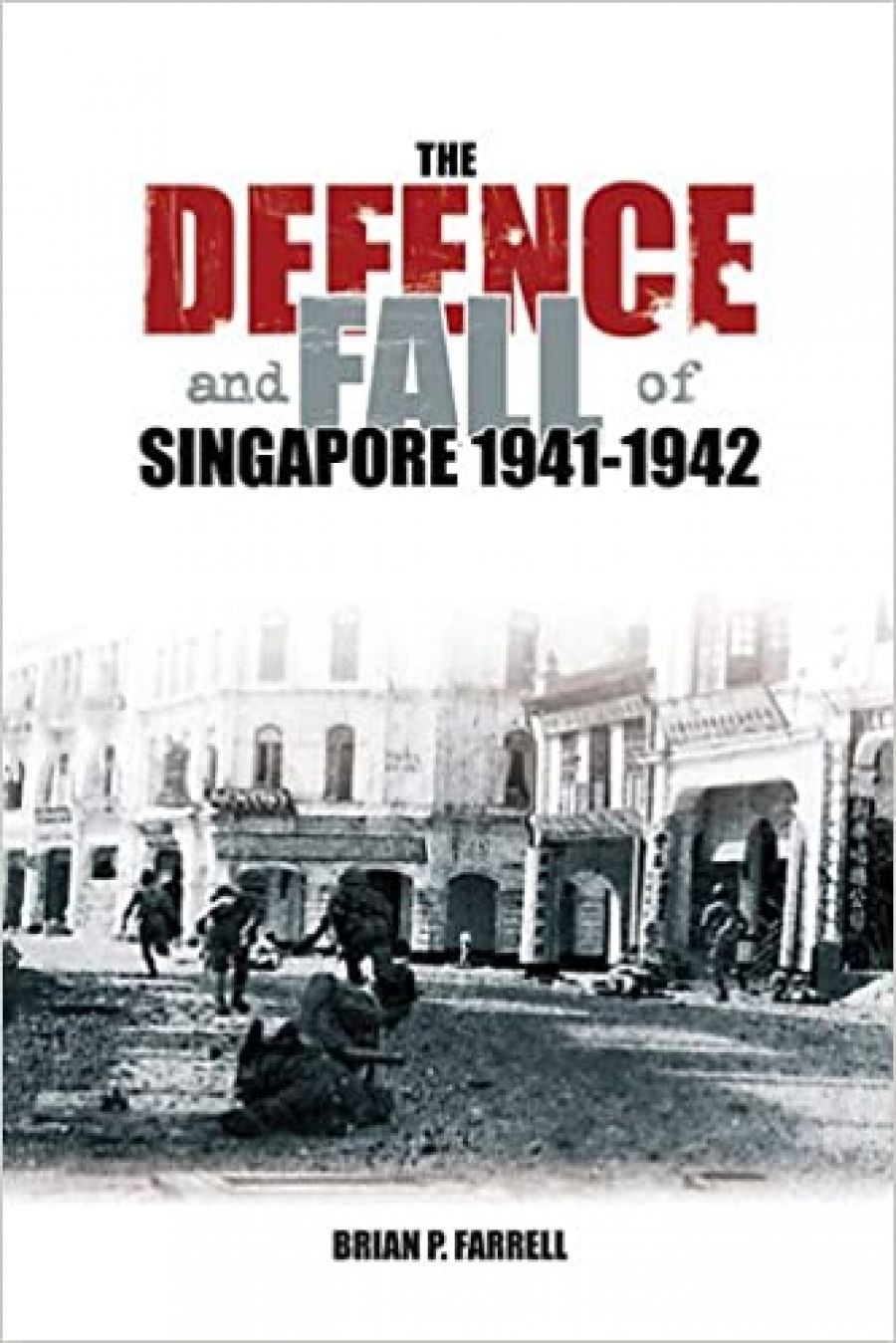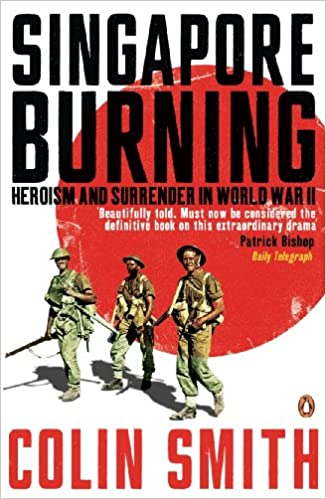
- Free Article: No
- Contents Category: International Studies
- Review Article: Yes
- Online Only: No
- Custom Highlight Text:
It is rare that two books of such quality should appear at the same time, especially on a subject as tragic but absorbing as the fall of Singapore. The reader is reminded immediately of films about the maiden voyage of the Titanic. You know that at the end of the film the ship has to sink: you also know that Singapore must fall with equally dramatic suddenness. Worse, in the case of Singapore, the systematic massacre (sook ching) of much of its overseas Chinese population by the Japanese kempetai (secret police) adds a huge dimension of tragedy to what is already a disaster; as does the fact that the Japanese, unlike most Western armies of the period, had no plans to deal effectively with more than 130,000 Allied prisoners, who were then dispersed and incarcerated in prisoner-of-war camps across South-East Asia and Japan itself. Every so often, these scenes are revisited by sympathetic writing, and also by new evidence and analysis, which is the case here.
- Book 1 Title: The Defence and Fall of Singapore 1940–1942
- Book 1 Biblio: Tempus Books, ₤13.99 pb, 447 pp, 0752437682
- Book 1 Readings Link: booktopia.kh4ffx.net/DXOyo
- Book 2 Title: Singapore Burning
- Book 2 Subtitle: Heroism and surrender in World War II
- Book 2 Biblio: Penguin, $49.95 hb, 628 pp, 0670913413
- Book 2 Cover Small (400 x 600):

- Book 2 Cover (800 x 1200):

- Book 2 Cover Path (no longer required): images/1_Meta/Sep_2020/META/516vjgzhTJL._SX324_BO1,204,203,200_.jpg
- Book 2 Readings Link: booktopia.kh4ffx.net/x4rLd
At the core of both books is the long, twisting story of the development of the Singapore naval base, situated vulnerably on the north shore of the island, less than a mile from Johore across the strait. It was supposed to underpin the vexed ‘Singapore Strategy’, which was hollow. The original idea was attractive enough. Build a working base, with the only dry dock capable of receiving capital warships east of Suez, so that, in the event that the Japanese got out of hand, the British main fleet, or a large part of it, would sally forth from the Atlantic and the Mediterranean, and deal with them. In 1919 and throughout the 1920s the strategy seemed to make sense to many people, especially the governments and peoples of Australia and New Zealand, who sought reassurance against an armed and dangerous Japan. They were right to do so, because, even though Japan had been an ally in World War I, few people doubted that it was capable of imperialist designs; it had already demonstrated such in China and Korea before that war. A main fleet base at Singapore seemed to provide a counter.
The trouble was that there were so many cross currents that rendered this a specious strategy. It looked good, but the likelihood of a simultaneous war in Europe would mean that the principal colonial powers in the region – Britain, France, and Holland – would be so preoccupied dealing with matters at home that there would be little chance that the Singapore Strategy could ever be given the teeth to make it a really formidable defence. In addition, Britain’s massive war debt, owed principally to the United States, meant that it had to accede to the scrapping of the Anglo-Japanese Treaty (over the strongly voiced objections of Australia and New Zealand). In the words of the Japanese foreign minister, quoted here by Colin Smith, the treaty ‘was discarded like a used pair of sandals’.
Japan’s resentment had also been reinforced by the Washington Conference of 1922, which set the capital ship ratio in the Pacific to the detriment of Japan. These issues are well developed in both these volumes. Of the two authors, Colin Smith is more descriptive of the effects that the Japanese invasion had on the everyday lives of the people of both Malaya and Singapore. Brian Farrell’s book is strongly analytical of how the Japanese went about their attacks, and of the uniqueness of their tactics down the length of Malaya and the fighting on Singapore Island. Both authors have used extensive primary material in archives and by interview. Smith quotes debts he has incurred ‘from Northumbria to Canberra’; Farrell, from the National University of Singapore, acknowledges the help of three particular friends who ‘walked through this story over and over again with me, on the ground and on paper’. The research by both authors could not be more impressive.
In Singapore Burning, Colin Smith paints a charming picture of what it must have been like to be a British civil servant or military officer in the balmy, pampered existence of Singapore and the Malay states in the 1920s and 1930s. Australian regular army officers, living in fibro huts and indifferent marital quarters at Puckapunyal and Holsworthy after World War II, might only drool over this description of life at Tanglin Barracks, Singapore:
Its main feature [the officers’ mess], was a large airy anteroom, opening onto a long roofed and beflowered verandah. On the floor above were the single officers’ quarters, each with two large rooms and a veranda – all looking across the immaculate nine-hole golf course surrounding the Mess to the massed purple bougainvillea of the Singapore Botanic Gardens. Behind, screened by tall tropical trees and flowering shrubs, were the excellent barrack blocks and married quarters.
This lotus-land existence came to an abrupt end in December 1941 with simultaneous Japanese landings at Singora (Songkla) and Pattani in Thailand, and at Kota Bharu on Malaya’s north-east coast. The upshot was one of unrelieved gloom for the combined British, Indian, Australian force, whose aircraft (too few and indifferent in performance to contest matters with Japanese ‘Zero’ fighters) and whose linear, World War I-style defences were quickly breached by the Japanese tactics of ‘driving charge’, akin to the German blitzkrieg. The Japanese gained the initiative early, and did not surrender it until the end.
Hugely impressive in its mastery of detail is Farrell’s analysis of the actual tactics used by the Japanese: the remorseless tempo of their advance on several axes, with large bodies of their troops on bicycles; their clever use of watercraft to get behind the defence and attack from the rear; and their frugal logistic system, which made them far less hampered in dealing with the geographic circumstances of Malaya than the British Empire forces, with their massive amounts of road transport. Most of all, Japanese battle procedures, which had been honed in more than a decade of fighting in Manchuria and China, were in almost every case faster and more enterprising than the defenders.
As bad as the situation was in trying to stop Yamashita’s numerically weaker XXVth Army advancing down the length of Malaya, the situation became worse on Singapore Island, with its short distances, massive civilian population and vulnerability (especially the docks area) to overwhelming Japanese command of the air. When Yamashita’s force crossed the Johore Strait onto Singapore Island on the evening of 8 February 1942, the defending British General Percival’s plan of trying to hold the whole island perimeter of 115 kilometres of mangrove and scrub – without mobile counter-penetration forces to prevent Japanese incursions, nor prepared defences in depth – meant that the defence was doomed from the start. Singapore surrendered on February 15, in what British Prime Minister Winston Churchill called ‘the worst disaster and largest capitulation in British military history’.
Not surprisingly, there was an immense hunt for scapegoats. In attributing blame, both authors produce their culprits. Farrell, in particular, looks broadly and deeply to the pre-war inability of Britain to match its straitened resources to its grand strategy in what was a clear case of imperial overstretch. Try as successive commanders of the Royal Navy did to ensure that, in the event of a Japanese attack, Malaya and Singapore would be relieved by the prompt arrival of a main fleet, by the eve of war they were forced to admit that it could not be done. The alternative was political: to appease Japan (in which policy the pre-war Australian government joined), and, when that failed, to attempt to deter Japan by despatching the two capital ships Prince of Wales and Repulse, but without an accompanying aircraft carrier. They were both promptly sunk by Japanese air attacks.
As an Australian military retiree myself, this reviewer applauds the fair way that Farrell has dealt with the claims of some writers that Australian troops were mainly to blame for letting the Japanese through their defences on Singapore Island. One slur (much quoted by sensationalists) held that the Australians were like daffodils, ‘beautiful to look at, but yellow all through’. Australian troops amounted to only fourteen per cent of the British command’s ground forces, but sustained seventy-three per cent of its battle deaths. Moreover, having walked the area at the north-west corner of the island, where two of Brigadier Harold Taylor’s depleted Australian battalions took the full weight of two Japanese divisions – one each – my personal contention is that only a soundly executed plan for counter-penetration and counter-attack forces to advance rapidly to support Taylor could have stopped Japanese penetration, similar to the way that Major-General Leslie Morshead did against Rommel’s forces during the siege of Tobruk. Percival and the Australian divisional commander, Gordon Bennett, were incapable of inspiring any such defence. Taylor was endeavouring to do the best he could in nearly impossible circumstances.
The culprits were not the Australians troops. Some of them, especially untrained reinforcements who arrived late in the day, had never fired their weapons. For them, even the simple Bren gun was rocket science. These troops did not perform well. But they were no worse than equally demoralised troops from Britain and India. The parade of culprits begins with the pre-war politicians and the impossible geo-strategic circumstances that were inflicted on every Allied country in the region, including General Douglas MacArthur’s command in the Philippines. In every case, threadbare colonial defences were unable to withstand a totally mobilised Japan and its rampaging forces – certainly not while many states were still fighting, or had already succumbed to German defeat in their metropolitan homelands in Europe.
These two highly readable books deepen our understanding of the course of the battles in up-country Malaya and Singapore Island.


Comments powered by CComment